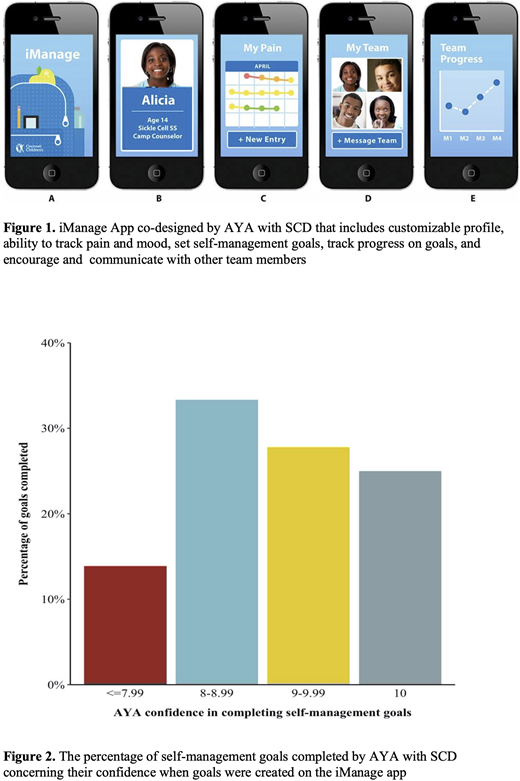Background: Sickle cell disease (SCD) is associated with medical challenges that often worsen for adolescents and young adults (AYA) when caregivers begin to transfer responsibility for care. Living with SCD requires self-management and self-efficacy and is a critical concern for AYA as they navigate complex medical systems. However, previous research indicates that AYA with SCD often lack the ability, confidence, and skills to manage their disease effectively. As most AYA with SCD are now "technology natives," mobile health (mHealth) holds considerable promise for assessing and changing behaviors to improve health outcomes. In a previous feasibility and acceptability study, AYA with SCD provided qualitative feedback that they would use mHealth (a co-designed mobile app) and that it was beneficial for tracking health behaviors. Thus, we integrated the mHealth app into a group intervention (SCThrive) and hypothesized that more engagement with the mHealth app would result in increased self-management and self-efficacy for AYA with SCD.
Methods: Our analysis from a single-site, randomized control trial (NCT02851615) assessed data from only AYA in the treatment arm (N = 26) who received the SCThrive intervention and used the mHealth app. The sample included AYA with SCD aged 13 to 21 years (Mage = 16.7 years; 54% female; 46% HbSS genotype; all African American/Black) who received six-weekly group sessions (3 in-person, 3 online). All SCThrive participants were provided with the mobile app (iManage) on an iPad. The Transition Readiness Assessment Questionnaire (TRAQ-5) assessed self-management skills and the Patient Activation Measure (PAM-13) assessed self-efficacy at baseline and posttreatment. We also assessed engagement (logins), confidence and completion of self-management goals (e.g., exercising, take medications), pain diary entries, and mood symptoms recorded on the iManage app (see Figure 1).
Results: Preliminary analyses indicated that most AYA with SCD logged on to the iManage app (Mlogins = 7.8, SD = 9.1, range = 1 - 45) and viewed their pain diary (Mviews = 5.7, SD = 9.1, range = 1 - 45) at least once a week. Eighty-eight percent of AYA saved a pain diary entry and the most commonly used strategies for managing pain episodes were resting (22%), drinking water (19%), and using distraction (8%). AYA viewed their self-management goals about once every 11 days (Mdays = 11.24, SD = 13, range = 0 - 57). All AYA created (Mgoals = 5.7, SD = .72, range = 4 - 7), but only 54% of AYA completed at least one self-management goal. Of the 149 self-management goals created by the entire sample, only 37 (25%) were recorded as completed. AYA with a confidence level of 7 or lower were least likely to complete their self-management goals (14%) (see Figure 2). Correlation analyses demonstrated that logging on to the iManage app more frequently was associated with completing more self-management goals (r = .38), documenting pain symptoms more frequently (r = .54), and lower mood ratings (r = .54).
Primary analyses demonstrated that after controlling for scores at baseline, the number of logins to the iManage app (p = .08, η2 = .13) predicted self-efficacy (PAM-13) and (p = .05, η2 = .17) self-management skills (TRAQ-5). Completing more self-management goals on the iManage app did not predict scores on the PAM-13, but, surprisingly, predicted lower scores (less self-management) on the TRAQ-5 (p = .08, η2 = .14).
Conclusion: Lessons learned from our study indicate that it can be challenging to maintain engagement in mHealth for AYA with SCD, but for those who do engage there are significant benefits related to self-management goals, documenting pain symptoms, and mood. Supporting hypotheses, engaging more with the iManage app was related to higher-reported self-efficacy and self-management skills. Some AYA engaged with the app infrequently and did not create or complete self-management goals; others were "super users" and logged into the app daily. Increasing the frequency of reminder messages, encouraging more interactions with peers, and tailoring the opportunity to earn incentives are potential modifications for future interventions. However, our findings indicate that a mHealth app can be effectively integrated into a clinical trial and is related to positive outcomes. Although there are challenges to address, mHealth has the potential to bring about changes in behavior and improve health in the SCD population.
No relevant conflicts of interest to declare.
Author notes
Asterisk with author names denotes non-ASH members.


This feature is available to Subscribers Only
Sign In or Create an Account Close Modal